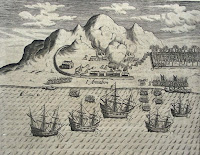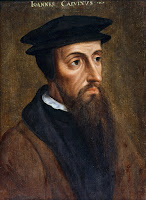~Some details are sketchy. You can help us!~
February 23, 1605 - Amsterdam - Frans Banninck Cocq is born
February 27, 1605 - Amsterdam - Frans Banninck Cocq is baptized (a scandal, because his parents, Jan Jansz Cock and Lysbeth Frans, were not married
September 17, 1605 - Amsterdam - Jan Jansz Cock and Lysbeth Frans notice their marriage at the Town Hall
April 24, 1607 - Haarlem - His brother Jan Cocq is born
September 1(?), 1623 - Amsterdam - His mother Lijsbeth dies, aged 42
June 1, 1625 - Poitiers, France - Arrives at Poitiers, France, to study Law
April 26, 1626 - Saumur, France - Visit to Saumur
September 16, 1626 - Poitiers - Departs from Bourges
November 15, 1626 - Bourges - Moves to Bourges to continue his studies
April 16, 1627 - Bourges - Departs from Bourges
January(?) 1(?), 1630(?) - Amsterdam - Frans Banninck Cocq returns to Amsterdam as a Doctor in Law
April 24, 1607 - Haarlem - His brother Jan Cocq is born
September 1(?), 1623 - Amsterdam - His mother Lijsbeth dies, aged 42
June 1, 1625 - Poitiers, France - Arrives at Poitiers, France, to study Law
April 26, 1626 - Saumur, France - Visit to Saumur
September 16, 1626 - Poitiers - Departs from Bourges
November 15, 1626 - Bourges - Moves to Bourges to continue his studies
April 16, 1627 - Bourges - Departs from Bourges
January(?) 1(?), 1630(?) - Amsterdam - Frans Banninck Cocq returns to Amsterdam as a Doctor in Law
April 23, 1630 - Amsterdam - Marries Maria Overlander van Purmerland
October 18, 1630 - The Hague - Volkert Overlander, his father-in-law and one of the founders of the East India Company, dies. Banninck Cock inherits his properties, including a canal house, the castle of Ilpenstein north of Amsterdam along with the title Lord of Purmerland and Ilpendam =(START)
 |
| The Night watch, 1642 (Rembrandt) |
January(?) 1(?), 1633 - Amsterdam(?) - Commissioner of the college of marital affairs
August 22, 1633 - Amsterdam - His father, Jan Jansz Cock dies, aged 58
January(?) 1(?), 1634 - Amsterdam - Becomes member of the City Council
August 22, 1633 - Amsterdam - His father, Jan Jansz Cock dies, aged 58
January(?) 1(?), 1634 - Amsterdam - Becomes member of the City Council
January(?) 1(?), 1635 - Amsterdam - Lieutenant of the militia of district I and captain of district II (until 1646)
January(?) 1(?), 1636 - Amsterdam - Commissioner of the college of marital affairs
January(?) 1(?), 1638 - Amsterdam - Frans Banninck Cocq orders a painting of his company of Civic Guards from Rembrandt, to decorate a wall of the main hall on the first floor in the new headquarters of the City's "Schutterij"(Civic Guard) at the Kloveniers Voorburgwal.
January(?) 1(?), 1642 - Amsterdam - Rembrandt completes the "Night watch"" for Frans Banninck Cocq
January(?) 1(?), 1638 - Amsterdam - Frans Banninck Cocq orders a painting of his company of Civic Guards from Rembrandt, to decorate a wall of the main hall on the first floor in the new headquarters of the City's "Schutterij"(Civic Guard) at the Kloveniers Voorburgwal.
 |
| Banninck Cocq (on the left) with the Amsterdam archery Militia, 1653 |
January(?) 1(?), 1646 - Amsterdam - Promoted to Colonel
January(?) 1(?), 1648 - Amsterdam - Holds the function of governor of the Amsterdam "longbowmen's shooting range"
January(?) 1(?), 1650 - Amsterdam - Appointed Burgemeester (Mayor) of Amsterdam
January(?) 1(?), 1653 - Amsterdam - Frans Banninck Cocq is re-elected as Burgemeester of Amsterdam
January 6, 1655 - Amsterdam - Frans Banninck Cocq dies, aged 49 =(END)
Bibliography
MEE Jr. Charles L. - "Rembrandt: A life"
Bibliography
MEE Jr. Charles L. - "Rembrandt: A life"







